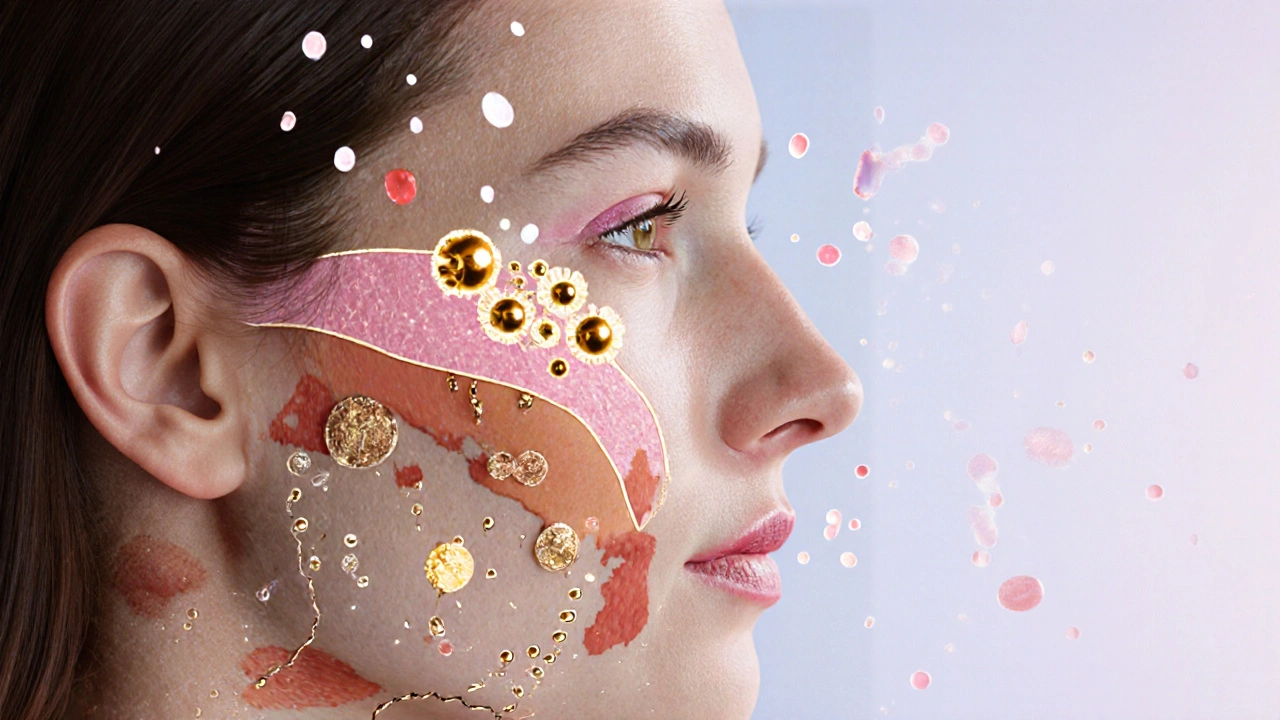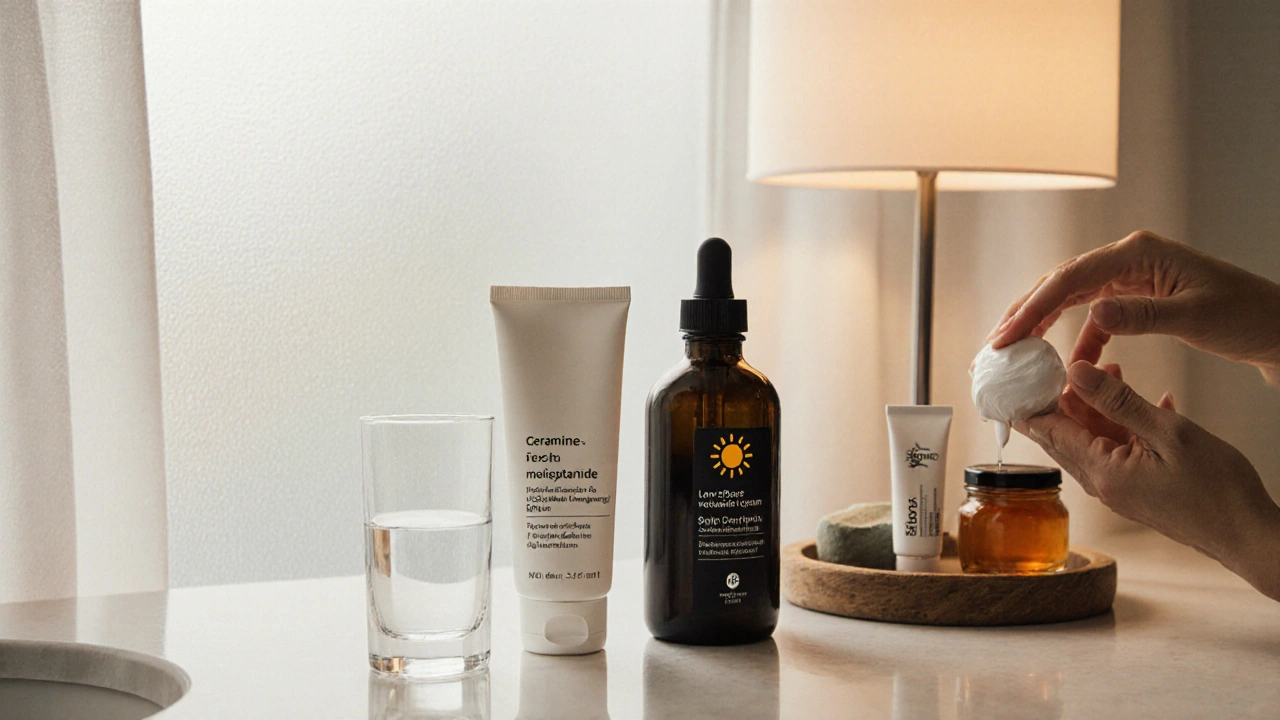How to Keep Your Skin Healthy During Hormonal Fluctuations
 Oct, 12 2025
Oct, 12 2025
Key Takeaways
- Hormones like estrogen, progesterone, and testosterone directly affect oil production, moisture levels, and inflammation in the skin.
- Identify which skin issue you’re dealing with-acne, dryness, oiliness, or hyperpigmentation-to choose the right routine.
- Support your skin from the inside with balanced nutrition, adequate hydration, stress management, and quality sleep.
- Adjust your skincare products: gentle cleanser, barrier‑repair moisturizer, daily sunscreen, and targeted actives such as niacinamide or salicylic acid.
- Consider supplements (vitamin D, zinc, omega‑3) and, if needed, medical advice for hormonal therapy.
Understanding Hormonal Fluctuations and Their Impact on Skin
When hormones swing, your skin often feels the ripple. hormonal skin care becomes a balancing act of calming inflammation, maintaining moisture, and protecting the barrier. Hormones are chemical messengers that travel through the bloodstream, telling cells how to behave. The main players for skin health are Estrogen, which generally promotes collagen production and hydration, and Progesterone, which can increase oil production. Testosterone (or its derivative, dihydrotestosterone) boosts sebum, often leading to breakouts.
These hormones rise and fall during menstrual cycles, pregnancy, postpartum, perimenopause, and menopause. Even stress‑induced cortisol can throw the mix off, making skin look dull or inflamed. Knowing the timing-whether it’s the luteal phase of a cycle or the early stages of menopause-helps you anticipate what your skin might demand.
Common Skin Issues During Hormonal Changes
Most people notice one or more of the following problems:
- Acne spikes often appear in the week before a period or during perimenopause, driven by increased sebum and inflammation.
- Dry, flaky patches can surface when estrogen drops, especially during menopause, reducing hyaluronic acid and natural oils.
- Excess oiliness may dominate the mid‑cycle when progesterone peaks, leaving a shiny complexion and larger pores.
- Hyperpigmentation or melasma can worsen under hormonal influence, manifesting as brown patches on the cheeks and forehead.
Each issue has a different root cause, so a one‑size‑fits‑all routine rarely works. Tailoring your approach to the specific symptom will give faster, clearer results.

Lifestyle and Nutrition Strategies
The skin you see is a reflection of what you eat, how you move, and how well you rest. Here are evidence‑backed habits that calm hormone‑driven flare‑ups:
- Balanced Diet: Aim for a plate that’s 40% vegetables, 30% protein, 20% whole grains, and 10% healthy fats. Low‑glycemic carbs (sweet potatoes, quinoa) keep insulin steady, which in turn stabilizes androgen levels.
- Hydration: Drink at least 2L of water daily. Dehydration weakens the skin barrier, making it more prone to irritation.
- Omega‑3 Fatty Acids: Fatty fish like salmon or a daily algae supplement supply EPA and DHA, which reduce inflammatory cytokines linked to acne.
- Vitamin D: Sun exposure of 10‑15 minutes a few times a week or a supplement (1000‑2000IU) supports barrier repair and modulates immune response.
- Zinc: A 30mg zinc picolinate dose can lower sebum production and calm inflamed lesions.
- Stress Management: Practices like mindfulness, yoga, or a 10‑minute breath exercise lower cortisol, indirectly curbing oil spikes.
- Sleep: 7‑9 hours of quality sleep each night allow skin cells to regenerate and hormone rhythms to settle.
- Regular Exercise: Moderate cardio boosts circulation, delivering nutrients to skin cells and helping hormone balance.
These habits work together like a team; you don’t need perfection, just consistency.
Skincare Routine Adjustments
When hormones are the variable, your routine should be the constant-simple, gentle, and adaptable.
- Cleanser: Choose a sulfate‑free, pH‑balanced formula that removes excess oil without stripping. Look for Salicylic Acid (0.5‑2%) if you’re prone to breakouts, because it penetrates pores and dissolves oil.
- Moisturizer: A barrier‑repair cream with ceramides, glycerin, and Niacinamide (5%) helps lock in moisture, soothe redness, and regulate sebum production.
- Sunscreen: Broad‑spectrum SPF30+ every morning-regardless of season-prevents UV‑induced melasma and protects the barrier while you’re using actives like retinol.
- Targeted Treatments:
- For acne, rotate a low‑dose Retinol (0.25‑0.5%) at night, or a benzoyl peroxide spot treatment (2.5%).
- For dryness, add a hyaluronic acid serum before the moisturizer and consider a richer night cream with shea butter.
- For hyperpigmentation, incorporate a vitaminC serum (10‑15%) in the AM and a niacinamide or azelaic acid product in the PM.
- Exfoliation: Use a chemical exfoliant (AHA/BHA) 2‑3 times a week-never a harsh physical scrub-to keep dead cells from clogging pores.
Never introduce more than one new product at a time. Give each ingredient 2‑4 weeks to show results before swapping.
Ingredient Guide: What Helps and What to Avoid
| Ingredient | Benefit for Hormonal Skin | When to Use |
|---|---|---|
| Salicylic Acid | Penetrates pores, reduces oil and inflammation | Acne‑prone phases (pre‑period, perimenopause) |
| Niacinamide | Balances sebum, strengthens barrier, fades discoloration | Daily, all phases |
| Retinol | Boosts collagen, unclogs pores, evens tone | Nighttime, start low during sensitive months |
| Vitamin C | Antioxidant, brightens hyperpigmentation | Morning, especially when melasma flares |
| Fragrance/Alcohol | Can irritate and strip barrier | Avoid during dryness or post‑breakout healing |
Stick to a short, focused ingredient list. Overloading your skin with actives often backfires, especially when hormones are already causing instability.

Supplements and Medical Options
When diet alone isn’t enough, targeted supplements can tip the scale back toward balance.
- Vitamin D: 1000‑2000IU daily supports barrier function and reduces inflammatory lesions.
- Zinc: 30mg zinc picolinate helps cut excess oil and speeds wound healing.
- Omega‑3 (EPA/DHA 1g): Lowers systemic inflammation, beneficial for both acne and dry skin.
- Evening Primrose Oil: Gamma‑linolenic acid can improve moisture in estrogen‑deficient skin.
If symptoms are severe-persistent cystic acne, extreme dryness, or rapid melasma progression-consult a dermatologist or endocrinologist. Options may include topical prescription retinoids, hormonal contraceptives, or low‑dose transdermal hormone therapy, all tailored to your specific hormonal profile.
Quick Checklist for Hormonal Skin Days
Keep this list on your fridge or phone. Tick off each step as you go.
- Morning: Cleanse → VitaminC serum → Niacinamide moisturizer → SPF30+
- Mid‑day: Reapply sunscreen if outdoors; sip water (aim for 250ml).
- Evening: Double‑cleanse (if wearing makeup) → Salicylic acid or AHA (2‑3×/week) → Retinol (alternating nights) → Ceramide‑rich night cream.
- Weekly: Exfoliate chemically, mask with clay (oil‑control) or honey (hydrating) based on skin need.
- Lifestyle: 7‑9h sleep, 30min walk, 10min meditation, balanced meals with omega‑3.
Adjust the frequency of actives when you notice heightened sensitivity-your skin will thank you.
Frequently Asked Questions
Why does my skin break out right before my period?
During the luteal phase, progesterone spikes and estrogen drops. This hormonal shift increases sebum production and can cause a mild inflammatory response, leading to the familiar pre‑menstrual blemishes.
Can I use retinol if I’m experiencing hormonal acne?
Yes, but start with a low concentration (0.25%) and apply every other night. Retinol promotes cell turnover and reduces clogged pores, but it can be irritating if the barrier is compromised, which is common during hormonal flare‑ups.
What foods should I avoid to calm hormonal skin issues?
Highly processed carbs, sugary snacks, and dairy can spike insulin and IGF‑1, both of which can amplify androgen activity. Reducing these and focusing on whole foods helps keep oil production steadier.
Is sunscreen really necessary if I spend most time indoors?
Absolutely. UV rays penetrate windows, and hormones already make the skin more prone to melasma. A thin SPF30+ moisturizer offers protection without feeling heavy.
How long does it take to see results after adjusting my routine?
Most actives (retinol, niacinamide, salicylic acid) need 4‑6weeks to show noticeable changes. Lifestyle habits like diet and sleep can have quicker effects on inflammation, often within a couple of weeks.


Sarah Aderholdt
October 12, 2025 AT 14:57Hormonal shifts can be a real mood‑swing for your skin, but a steady routine keeps things in check. Focus on gentle cleansers and barrier‑repair moisturizers, especially when you notice extra oil. Adding niacinamide daily can calm both redness and excess sebum. Remember, consistency beats intensity every time.
Phoebe Chico
October 24, 2025 AT 04:44Ah, the poetic dance of estrogen and testosterone, a symphony most miss because they’re too busy scrolling TikTok. Imagine your skin as a battlefield where hormones throw confetti; you need the right artillery – think salicylic acid and vitamin C like the twin swords of justice. Don’t let big‑pharma hype drown out the humble omega‑3s – they’re the unsung heroes of calm. And while you’re at it, slap on that SPF like armor, even if you’re just texting from the couch. The universe may be chaotic, but your skincare game doesn’t have to be.
Larry Douglas
November 4, 2025 AT 18:31When it comes to hormone‑related skin issues the literature emphasizes the importance of a balanced diet low in glycemic load and rich in antioxidants. Adequate hydration supports the stratum corneum and reduces transepidermal water loss. Omega‑3 fatty acids have been shown to modulate inflammatory pathways that contribute to acne. Vitamin D plays a role in barrier repair and innate immunity, making supplementation worthwhile for many individuals. In practice a stepwise approach-cleanser, niacinamide, sunscreen-allows the skin to adapt without overwhelming the barrier.
Michael Stevens
November 16, 2025 AT 08:17Exactly, Larry. Starting simple and adding actives one at a time lets you see what actually helps. I’ve seen clients swear by a morning niacinamide serum paired with a ceramide night cream.
Ann Campanella
November 27, 2025 AT 22:04Sounds like a lot of extra steps for me.
Desiree Tan
December 9, 2025 AT 11:51It might feel like a regimen, but think of each product as a tiny investment in your skin’s future. A gentle cleanser keeps pores clear without stripping, and a barrier‑rich moisturizer locks in the benefits of any actives you add later. If you’re dealing with breakouts, a low‑dose retinol at night can speed up cell turnover without causing massive irritation. Consistency over time will definitely outpace sporadic over‑treatment.